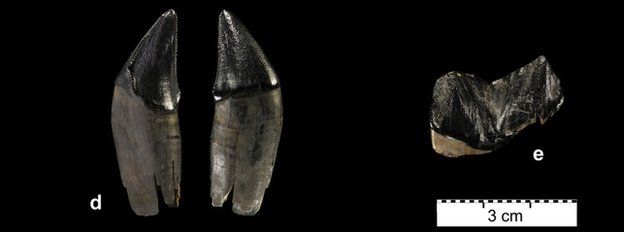- 2 December 2015
Our ancient human cousins may have fought off big cats with spears, according to archaeological evidence.
The sabre-toothed cat lived alongside early humans, and may have been a fearsome enemy, say scientists.Several feline teeth - and a chunk of arm bone - were uncovered at a site in Germany known for the oldest discovery of human spears.
The 300,000-year-old animal fossils are described as "spectacular".
The sabre-toothed cat - once known as the sabre-toothed tiger - lived from about 55.8 million to 11,700 years ago.
The predator had enormous teeth, which it used to rip through flesh.
Dr Jordi Serangeli, of the University of Tubingen, Germany, said the remains proved for the first time that the sabre-toothed cat was living in Europe alongside early humans.
"We can say that the humans - and the sabre-toothed cat - were living 300,000 years ago in the same area, in the same landscape," he told BBC News.
"The humans were hunters but they were not alone; they had to defend themselves from all the big carnivores."
Human hunters
Homo Heidelbergensis was among the first type of early human to use wooden spears.Scatterings of animal bones found in their camps suggest they used the spears to hunt animals like the horse and deer.
The latest find of five teeth and a bone from two individual sabre-toothed cats at a former coal mine in Schoningen near Hanover gives a new insight into the perils faced by early humans.
The cat's humerus bone - worked by humans into a rudimentary hammer- is the first example of its kind anywhere in the world, he added.
'Killed the cat'
Dr Mark Roberts of UCL, London, is an archaeologist at the Boxgrove site in southern England, which was home to one of Britain's oldest known human occupants, Homo heidelbergensis, 500,000 years ago.Evidence shows "hominins (humans and their ancestors) were already the top predator at this time; they were able to kill and butcher, without interruption and competition, large animals such as rhino, bison, horse and giant deer", he said.
But it is uncertain if humans around at the time used weapons to kill the sabre-toothed cat, he added.
"If it could have been demonstrated that hominins killed the cat then that would have been very interesting but without more skeletal material that is impossible to demonstrate."
The Schoningen excavation is a cooperation between the University of Tübingen and the State Service for Cultural Heritage of Lower Saxony.
source


No comments:
Post a Comment